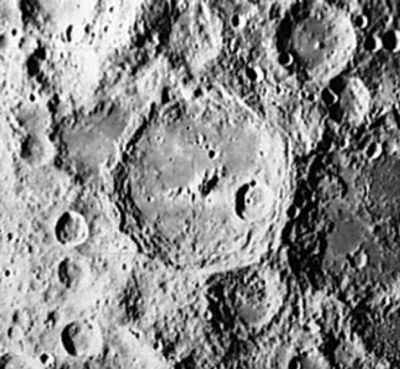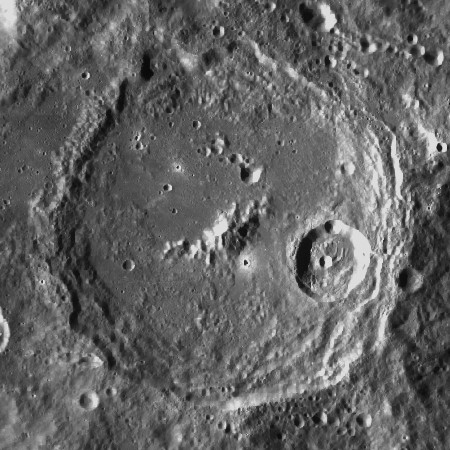Keeler
Contents
Keeler (with Planté on the ESE part of its floor)
|
Lat: 10.2°S, Long: 161.9°E, Diam: 160 km, Depth: km, Rükl: (farside), Lower Imbrian |


Upper image: Lunar Orbiter II . Lower image: LROC
Both images show Keeler with the much smaller crater Planté located at about 3 to 4 o'clock on Keeler's floor.
Images
LPOD Photo Gallery Lunar Orbiter Images Apollo Images
Keeler S; a distinct crater west-southwest of Keeler itself, was captured on Apollo 8's AS08-12-2099.
Research: David Woods and colleagues (Apollo 8 Flight Journal).
Maps
Description
Description: Wikipedia
Additional Information
Nomenclature
- Named for James Edward Keeler (September 10, 1857–August 12, 1900), an American astronomer. Along with George Hale he founded and edited the Astrophysical Journal, the major journal of astronomy in the world today. He performed a spectroscopic study of Saturn's rings and proved that they could not be solid objects because they did not rotate at a uniform rate; rather, they had to consist of a swarm of small individual objects.
- The name Keeler was included in the list of J. N. Krieger and R. Konig for the crater on the moon's Near Side officially known as Opelt. That usage was never adopted by the IAU.
- Keeler was among the long list of farside names approved by the IAU in 1970 and published in Menzel, 1971.
- In the planning for Apollo 8, the first manned circumlunar mission (1968), this crater (which did not then have an official name) was referred to informally as "Gemini", and the unnamed region west of Keeler (between Keeler, Geiger, Beijerinck, and Ventris) was referred to informally as "Apollo", a name subsequently approved for use in connection with a completely different farside crater (source: Phil Stooke's LPOD).
- Rima Keeler (an unofficial name from D.Caes for the east-west running rille on the southwestern part of Keeler's floor: http://bit.ly/2mv3agE) (this is perhaps one of the most unexpected rilles on the farside of the moon!) - DannyCaes Jan 14, 2018
LPOD Articles
Bibliography
James E. Keeler in the Sourcebook Project:
- Color Phenomenon Attending the Earth's Shadow at Sunset (Popular Astronomy, 1899), see Rare Halos, Mirages, Anomalous Rainbows, and related electromagnetic phenomena (William R. Corliss, The Sourcebook Project, 1984).
- The Ring of Light surrounding Venus (Sidereal Messenger, 1883), see: Mysterious Universe, a handbook of astronomical anomalies (William R. Corliss, The Sourcebook Project, 1979).